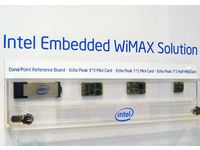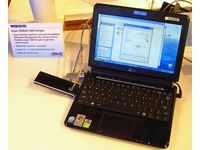WiMAX is Here! Special Expo in Hall 2
WiMAX or IEEE802.16 describes a wireless technology that will find its place above wireless networking, which have a limited range, and below GSM and 3G technology, which either isn’t available everywhere or is too expensive and slow. WiMAX has been available since 2004 and has found its way into many commercial applications. However, the breakthrough hasn’t happened due to an insufficient amount of hardware – especially on the client side and for small applications.
WiMAX will not only bridge the last mile and provide an alternative Internet access technology for ISPs, but it can also be used in places where traditional wireless networking hits the limits due to insufficient signal range. Don’t only think data: WiMAX is powerful and flexible enough to also support VoIP applications.

One of the key driving forces for WiMAX certainly is Intel, who is about to launch its Echo Peak wireless modules for the next generation mobile platform, which is called Montevina. Echo Peak is available in three flavors: The 3x3 mini cards support WiMAX and 802.11a/b/g/n, the 1x2 mini card is ready for 802.11a/b/g and the 1x2 half mini card supports only WiMAX. Expect one of these to be included in every Centrino 2 notebook system, although the WiMAX deployment was not made official yet.

Asus is one of the exhibitors of WiMAX hardware in Computex TWTC Hall 2. We saw a full range of products, including access points, routers, and also USB WiMAX interface cards. However, the demo system, which uses an ultra-portable EEEPC to showcase the WiMAX USB 2.0 card, was a bit off purpose, as the WiMAX card was almost as big as the EEEPC system it was operated on.
WiMAX was designed to provide high bandwidth and short response times. It supports encryption and QoS option (quality of service), which is particularly important to ensure good quality for VoIP calls. However, implementation largely depends on the particular service provider. WiMAX at 10 GHz and up is suitable for point-to-point connections at high bandwidth, while 2-11 GHz even works with small antennas. For metropolitan areas with lots of buildings, WiMAX is expected to have a range of 1-3 km. While bandwidth of over 100 Mbit/s is possible in best cases, all users connected to a WiMAX base station have to share the available bandwidth, which makes the whole thing tricky. However, wireless chipsets should be capable of roaming between WiMAX and WLAN once WLAN is available. In real life, we expect WiMAX to provide anything up to 2 Mbit/s bandwidth.
Since WiMAX will be of considerable value to Internet users who don’t have conventional options to connect to the world, we granted WiMAX and the related hardware that was presented at the WiMAX Expo our Computex 2008 Innovation Award.
Get Tom's Hardware's best news and in-depth reviews, straight to your inbox.

Patrick Schmid was the editor-in-chief for Tom's Hardware from 2005 to 2006. He wrote numerous articles on a wide range of hardware topics, including storage, CPUs, and system builds.
-
virtualban Now get that wireless power transmission working as in theory (possibly without harm to humans), and there you go, the perfect wireless office/home environment...Reply